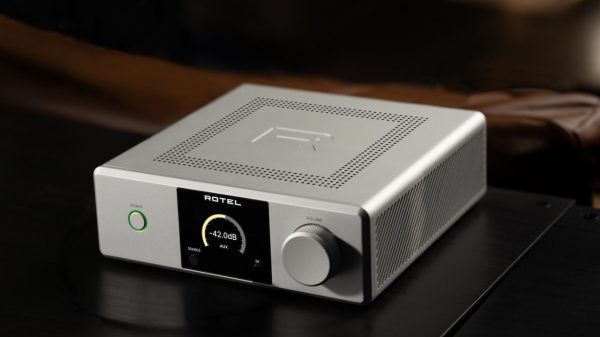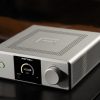I’ll have a lot more to say about the Vincent SV-737 Integrated Tube Stereo Amplifier next week in the second part of my review but I wanted to give a brief introduction and share some early thoughts about this surprising and truly excellent amplifier.
The SV-737 is a hybrid amplifier that utilizes 5 tubes: 2 x 6N1P, 2 x 6N2P, and a single 85A2 creating a beautiful orange hue in the dark through a circular window on the front panel. The quality of the casework is superb, and I rather like how the edges of the heatsinks on both sides of the chassis have been neatly rounded off.
Everything about this amplifier screams attention to detail and quality engineering. If they cut any corners on this product, one would be very hard pressed to find them; all the little things like the volume control, input jacks, binding posts, and remote control feel like they belong on a very expensive high-end component.

From an operational perspective, the Vincent SV-737 has proven to be bulletproof and superbly reliable. We’ve had the power go off twice this month due to weather and the Vincent turned right back on and has never missed a beat. It’s clearly designed to take a beating and keep on playing.
From a power perspective, the SV-737 outputs 180 watts/channel (8 ohms) and over 300 watts/channel (4 ohms); the amplifier didn’t even flinch connected to my pair of Magnepan LRS loudspeakers and drove them with the same authority as the $6,000 Cambridge Audio Edge A that I’ve owned for over a year. Considering the price difference between the two products, the SV-737 would be a great alternative with several loudspeakers.

I’ve used the Vincent SV-737 so far with the aforementioned Maggies, PSB Synchrony B600, Q Acoustics 3050i, Polk Audio L100, and Wharfedale EVO 4.2 loudspeakers.
The SV-737 became slightly warm driving the PSB Synchrony B600 at higher volume levels for more than 45 minutes without interruption but nobody really listens like that, and the amplifier behaved perfectly.
The SV-737 might utilize 5 tubes in the circuit but make no mistake – this is not a tube amplifier.
Does it offer a warm tonal balance and roll off the edges at either extreme?
Most certainly but it delivers a lot more low end control than any tube integrated amplifier I’ve tried and offers excellent clarity and detail depending on your sources.
Not a tube amplifier but flowing with tone and engagement; the LRS and PSB Synchrony B600 really loved this amplifier.
Donald Byrd’s “Cristo Redentor” is a hauntingly beautiful track that needs to be experienced on a good pair of horn speakers and 8 watts of SET power to feel that shiver down your spine. Byrd’s trumpet explodes out of the background after two minutes of choral build-up and I’ve heard it massacred more times than I care to admit through some expensive loudspeakers.
It’s a combination of the bite of the horns, Herbie Hancock’s piano, and the spirituality of the piece that often leaves me transfixed long after the track has concluded. If you’re not thinking about your place in the universe (or why you ate that second burrito before attempting to drive home from the Shore on the Garden State Parkway in July) as those final notes slowly decay – you’re in a much better place than I.
The Vincent SV-737 proves to be a willing dance partner for the PSB Synchrony B600 delivering the low end control it requires to fully energize the room but also the necessary resolution and midrange warmth to bring this neutral speaker out of its cocoon.

Make no mistake, the PSB Synchrony B600 is a world-class stand-mount that delivers more resolute bass response than some floor-standing speakers in the same category – but it’s never taking that huge step forward without an amplifier like the SV-737.
What surprised me the most about the Vincent (or St. Vincent as it became known in our home over the past few months) was its ability to transition from chamber music to electronica and then jazz piano without skipping a beat.
Unflinching. Seemingly unflappable.
Bill Evans and Thelonious Monk delivered with both the requisite weight and pacing that made me question why most people would need anything more than the $650 Magnepan LRS or Polk Audio L100 bookshelf loudspeakers.
The more I listened to the Vincent SV-737, the faster I started to realize that we’ve been doing this all wrong for the past few decades.
Telling all of you to buy the best speakers or source components that you can afford.
We’re wrong.
Buy the best amplifier that you can afford. Buy the amplifier that moves you to real tears and elevates your heartbeat to the point that you feel release.
Get the amplifier right and you can experiment with any type of loudspeaker you desire.

The Vincent isn’t perfect. I don’t understand not including a phono preamp in 2021 considering the price; especially when the brand makes some excellent external phono preamps that are well worth seeking out.
The Vincent SV-737 feels like a German version of the best Parasound Integrated Amplifiers which I think would make it very appealing for a lot of audiophiles. The John Curl-designed products offer very similar features and excellent value for the money.
The Parasound amplifiers offer greater transparency but also less color overall. The Vincent doesn’t carve out images with the same degree of specificity, but I love what it does with the human voice and how engaging it can be.
Continue reading part 2 of this review →



































Mike Cornell
August 28, 2021 at 6:17 pm
Hi Ian. Looking forward to part two….I may have to put this amp on my shopping list! Just wondering about the difference between the SV-737 and the SV-237 as they appear to be identical and power output is the same as well, I think. Maybe the 737 is an updated version of the 237?
Frank Bloehbaum
September 10, 2021 at 11:41 am
Hi Mike, the SV-737 is not just a SV-237 on steroids. The preamplifier has a much different circuit structure. The treble and bass control circuit (switchable to linear mode) is more elaborate, the preamplifier section works even more linear all in all. Because of that the 737 needs one tube (two triode systems) more than the SV-237. The poweramplifier is able to deliver more power at demanding loads like ribbon or electrostatic speakers. The SV-237 is a bestselling product and many customers are happy with it. The SV-737 is not an updated product (the SV-237 is and will be in production), it`s a product of it`s own on an even higher level than the established SV-237.
Ian White
September 10, 2021 at 1:17 pm
Mike,
It’s a fantastic product. One of the best integrated amplifiers I’ve tried in the past 10 years. It barely broke a sweat with the Magnepan LRS. I like it so much, that I might consider buying one this year to use with the used pair of MartinLogan Aerius i that I am having restored.
Best,
Ian
Mike Cornell
September 11, 2021 at 2:34 am
Thanks, Frank. Appreciate the clarification.
Brian
September 18, 2023 at 11:24 pm
I’ve owned this Vincent SV 737 hybrid for over a year now and it’s unbelievable…and for the price…wow it’s awesome! still saying that everyday I listen to it…it pairs quite well with the Dali Rubicon 2 and now using it with the Dali Rubicon 6 BE…had 2 Rel subs but save that extra money…one sounds better in my opinion…It has to be the best sleeper product ever…not many have heard it…they don’t market it much at all…German engineers are to thank for this wonderful hybrid amplifier… low price you wonder why? It would cost much more if it was manufactured in Germany, but it’s manufactured in China…that makes this a steal of a price because Germany makes sure it’s being buit right to there standards…
“no music no life”
Vito
January 27, 2025 at 4:19 pm
Hello i considering Electrocomponiet ECI 80D and Vincent SV 737. What you recomend?
Ian White
January 27, 2025 at 10:19 pm
Depends on the rest of the system. What were you thinking?
IW